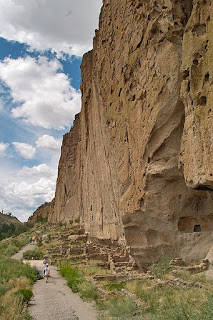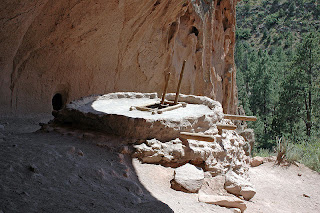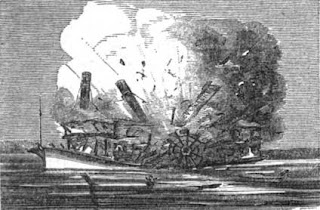The Sioux and the Black Hills
To the Sioux Indians, the Black Hills held a very special spiritual meaning. The Sioux were a very spiritual people who communicated with their spirits through dance and music. Their most important ritual was the Sun Dance. The Sun Dance ritual was a 12 day affair held during the summer. By nature the Sioux were warriors and the Sun dance was a way to build tribal unity and to assert one's individual courage. It was a self-sacrificing ceremony and included self-inflicted wounds. It helped establish it's participants as valiant warriors.
The Sioux claimed the Black Hills as their own during their westward move from the Minnesota region. The Sioux considered the Black Hills to be a place where communication existed between the earth realm and the spiritual realm. It was considered the center of their universe. It was something much more important to them than anything of material value. This was demonstrated during negotiations with the U.S. Government at Fort Laramie in 1868 when the treaty they signed gave the Sioux official ownership of the Black Hills. Much of this changed in 1874.
The Black Hills and Colonel Custer
Pictured at right is part of George Armstrong Custer's 1874 expedition into the Black Hills. The expedition was launched after several rumors surfaced attesting to the presence of valuable minerals there. Custers expedition entered the Black Hills from the north and split up into two groups. The exploring expedition also turned out to be a hunting trip where Custer reportedly shot a Grizzly Bear and called this feat the biggest hunting success of his life. The picture below left is of Custer with his prize.
The Custer expedition of 1874 determined that there were indeed valuable minerals in the Black Hills and dispatched a messenger back to Fort Abraham Lincoln with the news. The information was telegraphed back east and reached the newspapers. You can imagine what happened next. The country at that time was in a financial downturn and hoards of people made plans to head to the Black Hills and stake their claim.
From the perspective of the Sioux, the Black Hills were granted to them through the 1868 Fort Laramie Treaty. Even with the treaty in force, prospectors were in the Black Hills prior to the 1874 expedition greatly upsetting the Indians. In fact, General Sherman, the head of the Army in Washington, ordered troops to discourage prospectors from entering the area. His troops would turn back adventurers and if necessary confiscate their equipment and livestock.
Reports however were that miners in many cases were still able to reach the Black Hills. Now with the surge of people coming with the Custer news, the situation became much worse and the army could not begin to stop the invasion. There were simply too many people trying to get there. Again, to the Sioux, this was not just land. The Black Hills were a sacred place to them and they were not about to sell the land.
Sioux Anger Grows
Sitting Bull, pictured at left, was just one of the Sioux leaders who detested what was happening. The Sioux had been relegated to their reservation via the treaties but being hunters and warriors by nature, a good many ventured off the reservation particularly during the summer hunting season.
The invasion of the Black Hills by the whites made the Sioux even more hostile and restless. The Black Hills problem made militants out of many peaceful Indians.
In the beginning of westward migration, the Plains Indian for the most part traded with the settlers because at that point the emigrants were moving through the area. They were either heading to the California gold fields or to Oregon. The problems really began when the settlers stayed on and established camps and towns. Add to this the arrival of the professional buffalo hunter and his Sharps Rifle who essentially wiped out the seemingly endless herds and you have more Indian trouble.
The Black Hills invasion by the gold seekers was all it took to ignite a war. The irony is that George Armstrong Custer lost his life in an 1876 Sioux Indian War he actually had a hand in starting by sending word out to the eastern press in 1874 that indeed the Black Hills were filled with valuable minerals.
Mining in the Black Hills
The picture at right is of the Homestake Mine in 1889, one of the Black Hill's largest. In fact, the dream of later prospectors was to find their own Homestake Mine.
During the height of the gold rush, wagons of gold were hauled to Cheyenne, Wyoming for transport east. Some of these wagons might carry up to $300,000 in gold. Some were robbed by highwaymen and in one case guards were killed. An outraged populace put up to a $2,500 reward for the capture of the robbers and there were several lynchings as a result. The Black Hill's gold proved to be a large deposit and produced about 10% of the worlds gold supply over a 125 year period.
 Deadwood, SD was one of the largest settlements during the Black Hill's gold rush. The photo at right is Deadwood in 1876. The town had a reputation of being rough and violent. Whenever a town springs up with gold prospectors another element is not far behind. Gamblers, robbers, swindlers, murderers...all of these characters seemed to flow where the money was and Deadwood fit the bill.
Deadwood, SD was one of the largest settlements during the Black Hill's gold rush. The photo at right is Deadwood in 1876. The town had a reputation of being rough and violent. Whenever a town springs up with gold prospectors another element is not far behind. Gamblers, robbers, swindlers, murderers...all of these characters seemed to flow where the money was and Deadwood fit the bill.Today there are several interesting stops to make in the Black Hill's vicinity and the most popular of those is Deadwood.
The town symbolizes the old west and in particular the gold rush days. Many interesting events take place every year in Deadwood. It's not only a fun trip for the family but you'll also learn a lot about the gold mining industry including the everyday hardships and challenges faced by the early prospectors. You will see what life there was like in 1876 and also get some great photos.
Another related story you may find interesting is Sutter's Fort and the California Gold Rush.
The sites below give detailed information to help plan a visit.
www.deadwood.org
www.travalsd.com
www.fs.usda.gov/blackhills
www.tripsintohistory.com
Get your South Dakota travel guide and South Dakota maps at www.travelsd.com/About-SD/Request-Information
(Article copyright Western Trips. Photos and images in the public domain)
View Larger Map


















































